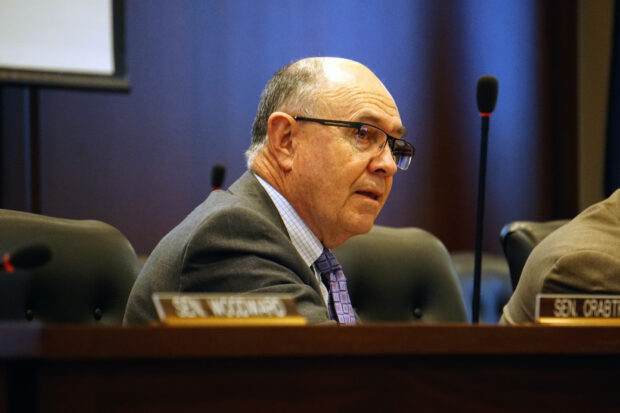A Senate committee Wednesday rejected a bill that would have armed public school teachers.
A theme of the debate was whether Senate Bill 1418 was designed to protect Second Amendment rights or to enhance school safety; in other words, how far could school districts go to regulate guns on campus?
The legislation required school districts to develop a policy allowing staff to carry guns, with baseline training conditions.
“This is a Second Amendment bill, not a school safety bill, and, to me, that’s an important distinction,” said Senate President Pro Tem Chuck Winder, R-Boise. “I think we’re better off holding it in committee, continuing to work on the issue.”
The Senate State Affairs Committee voted 5-4 in favor of Winder’s motion to table the bill. That was after a ruminative public hearing that swayed one Democrat to support the proposal, to her surprise.
“I have an ideology, I have a philosophy: no guns in schools,” said Senate Minority Leader Melissa Wintrow, D-Boise. “I started to soften as I listened to the testimony. … You guys convinced me that teachers, school folks should be able to make those policies and make those choices without me interfering with my flag in the ground.”
SB 1418 was an alternate to House Bill 415, from Rep. Ted Hill, R-Eagle. The earlier bill would have given school staff, contractors and volunteers with enhanced concealed carry permits the right to carry guns on campus, regardless of local policies. This bill also barred districts from posting “gun-free zone” signs. House Republicans overwhelmingly approved this bill in January.
Sen. Jim Guthrie’s new version — co-sponsored by Hill — would have required school districts to develop policies allowing staff with enhanced concealed carry permits to carry guns on campus. It added additional baseline training, including annual requalification and active shooter training. And it allowed “gun-free zone” signs as long as they referenced that staff could be armed.

One key difference from the House bill was the inclusion of input from people “embedded in our school systems, who care so much about the education and safety of our kids,” said Guthrie, R-McCammon. “At the very least, they’ve earned a seat at the table.”
The Idaho School Boards Association and Idaho Association of School Resource Officers strongly opposed HB 415. ISBA was neutral on the Senate bill, while the resource officers association supported it.
SB 1418 struck “a brilliant balance” between a personal decision to carry a firearm and local authority to set parameters on guns, in collaboration with law enforcement, said Morgan Ballis, president of the Association of School Resource Officers.
Stu Hobson, a former Nampa school resource officer, also lauded a provision to allow districts to regulate the type of weapons and ammunition permitted on campus. The bill is designed to protect “our kids and our staff,” Hobson said, and “certain rounds and certain types of weapons do not match with that safety concern.”
That was a sticking point for Winder. “Those are legitimate concerns, but as you look at this, I think that could really cause a major problem, too, with people defending themselves.”
Winder also questioned the affordability of training requirements and whether school districts would cover them. “There are still some issues here that aren’t resolved.”

Representatives of the Idaho Freedom Foundation, Idaho Second Amendment Alliance and National Rifle Association testified against the bill. They argued it would be more restrictive than current law and opposed the provision allowing “gun-free zone” signs.
“There is no justifiable reason an elected education official should determine the type of firearm or ammunition an individual may carry in self defense,” said NRA state director Aoibheann Cline. “That is a highly personal decision.”
A few committee members referred to significant public interest in the bill, prompting many unsavory emails. Guthrie said he received hundreds that were “hateful and threatening.”
State Affairs held two votes on the bill. Before approving Winder’s motion to table it, the committee rejected Assistant Majority Leader Abby Lee’s motion to advance the bill to the Senate floor, where it could be amended. “I’m afraid that we might leave with nothing.”
Lee, R-Fruitland, argued it was a school safety bill: “The Second Amendment is very clear, but we have constructs already, where our schools are different, courts are different, our airports are different. … I recognize that these things can be treated differently.”
New library bill passes House easily, but not quietly
After a fiery floor debate, the House once again passed a bill designed to restrict access to obscene library materials.
The latest version of the library bill, House Bill 710, would require public and school libraries to restrict access to materials deemed harmful to minors. After receiving a written objection, libraries would have 30 days to remove the materials, or face a civil penalty of up to $250.
To a large extent, Wednesday’s debate echoed back to previous debates over earlier versions of library bills.
“Here we go again,” said Rep. Lori McCann, R-Lewiston, who said HB 710 was nearly a carbon copy of a library bill Gov. Brad Little vetoed a year ago.
Rep. Brent Crane, R-Nampa, said the new bill contained new tweaks, such as the 30-day deadline. He also referred back to the first library bill that passed in 2022 — which said librarians could face a jail sentence if they failed to follow the law.
“If this doesn’t pass, we’re going back to that,” he said. “This issue is going to get solved one way or the other.”
Tempers flared twice.
As Nampa Republican Rep. Kenny Wroten continued a long, freewheeling debate against the bill, Eagle Republican Rep. Josh Tanner objected and accused Wroten of filibustering. “At some point in time we need to get back to the bill,” Tanner said.
At another stage of the debate, Crane blasted opponents of HB 710 and previous proposals. “Why are we fighting so hard to put obscene material in front of our children?”
McCann objected. The House then put the debate on hold, and several lawmakers, visibly angered, left the House floor for a closed-door discussion.
The bill passed a few minutes later on a 47-23 vote.
Co-sponsored by Rep. Jaron Crane, R-Nampa, House Speaker Mike Moyle, R-Star, and Senate President Pro Tem Chuck Winder, R-Boise, the bill now goes to the Senate.
JFAC approves higher-ed line items
Budget-writers carved out more money for employee pay raises at the state’s two-year colleges, and some money to help Boise State University accommodate growth.
They did this in two followup budget bills that now must pass the House and Senate.
The first bill, a community colleges budget, included more than $1.8 million for “operational capacity enhancement,” a line item that can go toward pay raises.
Gov. Brad Little requested $1.3 million for this line item.
“We’re looking to enhance salaries a little bit,” said Sen. Janie Ward-Engelking, D-Boise, explaining the $500,000 increase, which the Joint Finance-Appropriations Committee passed unanimously.
Colleges and universities face a perennial challenge with pay raises. The Legislature does not always fully fund raises, forcing the schools to cover the balance from student tuition and fees. This year, the state has proposed 3% employee raises.
JFAC later passed a budget for the Permanent Building Fund, which covers state capital projects.
Budget-writers made one change: They cut the appropriation for Boise State’s science and research building from $15 million to $13 million. The $2 million balance would go toward Boise State’s line item for enrollment workload adjustment, which is designed to cover the costs of growth.
The funding shift doesn’t necessarily slow the science building project, which will cost about $120 million. Boise State has said it will need to use bonds and donor support to bankroll the balance of the project.
The Permanent Building Fund budget also covers a host of other education projects: $7 million for physician’s assistant program facilities at Idaho State University; $4 million for the University of Idaho’s Meat Science and Innovation Center and McCall Outdoor Science School; $6.1 million for projects at Lewis-Clark State College; and $7 million for projects at the Idaho School for the Deaf and the Blind, including new cottages for residential students.
The Permanent Building Fund budget passed on an 19-1 vote, with Rep. Tina Lambert, R-Caldwell, in opposition.
Steps for Schools raises $48,000
Steps for Schools, an annual walking challenge promoting physical activity, last month generated $48,000 in donations for Idaho schools to buy exercise equipment or programs.
Sixty-six state lawmakers and constitutional officers raised money for 60 different schools or school districts, according to the Blue Cross of Idaho Foundation for Health, which sponsors the event.
“We’re grateful that so many of Idaho’s legislators and constitutional officers made the effort to participate in Steps for Schools during the busy legislative schedule and helped a local school or school district in the process,” Kendra Witt-Doyle, executive director of the foundation, said in a news release.
Participants earned $500 for the school of their choice if they walked at least 145,000 steps in February and $1,000 for 290,000 steps. The event has raised more than $316,000 for schools since 2015.
